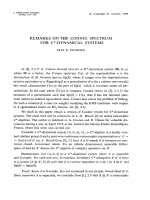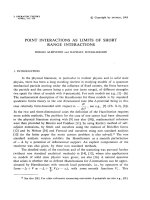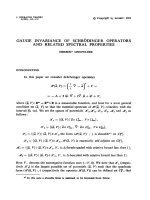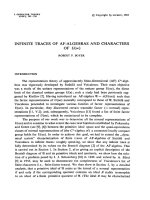Báo cáo toán học: "Wilf-equivalence on k-ary words, compositions, and parking functions" pptx
Bạn đang xem bản rút gọn của tài liệu. Xem và tải ngay bản đầy đủ của tài liệu tại đây (121.82 KB, 9 trang )
Wilf-equivalence on k-ary words, compositions, and
parking functions
V´ıt Jel´ınek
∗
Department of Applied Mathematics, Charles University, Prague
Toufik Mansour
Department of Mathematics, Haifa University, 31905 Haifa, Israel
Submitted: May 9, 2008; Accepted: May 4, 2009; Published: May 11, 2009
Mathematics Subject Classification: Primary 05A18; Secondary 05E 10, 05A17, 05A19
Abstract
In this paper, we study pattern-avoidance in the set of words over the alphabet
[k]. We say that a word w ∈ [k]
n
contains a pattern τ ∈ [ℓ]
m
, if w contains a
subsequence ord er-isomorphic to τ . This notion generalizes pattern-avoidance in
permutations. We determine all the Wilf-equivalence classes of word patterns of
length at most s ix.
We also consider analogous problems with in the set of integer comp ositions and
the set of parking functions, which may both be regarded as special types of words,
and which contain all permutations. In both these res tricted settings, we determine
the equ ivalence classes of all p atterns of length at most five.
As it turns out, the full classification of these short patterns can be obtained
with only a few gen eral bijective arguments, which are applicable to patterns of
arbitrary size.
1 Introduction
In this paper, we study patterns avoidance in the domains of words, integer partitions,
and parking functions. This can be seen as an extension of the frequently studied con-
cept of pattern avoidance of permutation patterns. Our results extend previous work of
Burstein [4], who described the equivalence classes of k -ary words of length at most 3, and
∗
Supported by the project MSM0021620838 of the Czech Ministry of Education, and by the grant
GD201/05/H014 of the Czech Science Foundation.
the electronic journal of combinatorics 16 (2009), #R58 1
of Savage and Wilf [14], who described the equivalence classes of integer compo sitions of
length at most 3. O ur classification is largely based on several new bijective arguments,
inspired by the ideas from Krattenthaler [11], Backelin, West and Xin [3], and Jel´ınek and
Mansour [9].
1.1 k-ary words
Let [k] = {1, 2, . . . , k} be a totally ordered alphabet of k letters, and let [k]
n
denote the
set of words of length n over this alphabet.
Consider two words, σ ∈ [k]
n
and τ ∈ [ℓ]
m
. Assume a dditionally that τ contains all
letters 1 through ℓ (a word with this prop erty will be called a pattern). We say that σ
contains an occurrence of τ, or simply that σ contains τ, if σ has a subsequence order-
isomorphic to τ , i.e., if there exist 1 ≤ i
1
< . . . < i
m
≤ n such that, for any two indices
1 ≤ a, b ≤ m, σ
i
a
< σ
i
b
if and only if τ
a
< τ
b
. If σ contains no occurrences of τ, we say
that σ avoids τ . For a pattern τ, let [k]
n
(τ) denote the set of k-ary words of length n
which avoid the pattern τ. Let f
τ
(n, k) be the number of τ-avoiding words in [k]
n
, i.e.,
f
τ
(n, k) = |[k]
n
(τ)|.
We say that two patterns τ and τ
′
are word-equivalent (or, more briefly, w-equivalen t),
and we write τ
w
∼ τ
′
, if for all values of k and n, we have f
τ
(n, k) = f
τ
′
(n, k).
There are two o perations on words which trivially preserve the w-equivalence, called
the reversal and the complement. The reversal of a word τ ∈ [k]
m
, denoted by r(τ ), is
obtained by writing the letters of τ in the reverse order, i.e., the i-th letter of r(τ ) is equa l
to the (m−i+1 ) -th letter of τ. The complement of a word τ, denoted by c(τ), is obtained
by turning τ “upside-down”, i.e., a letter j is replaced by the letter ℓ−j +1, where ℓ is the
largest letter of τ. For example, if ℓ = 3, m = 4, then r(1232) = 2321, c(1232) = 3212,
r(c(1232)) = c(r(1232 )) = 2123. Clearly, c ◦ r = r ◦ c and r
2
= c
2
= (c ◦ r)
2
= id, so r, c
is a group of symmetries of a rectangle.
Several authors have previously considered pattern avoidance in words [1, 2, 4, 5, 10,
13]. In 1998, Burstein [4] proved that 123
w
∼ 132. In 2002 , Burstein and Mansour [5]
proved that 121
w
∼ 112. By these two results we obtain that there are 3 w-equiva lence
classes of patterns of length three:
• 111,
• 112
w
∼ 121
w
∼ 122
w
∼ 211
w
∼ 212
w
∼ 221,
• 123
w
∼ 132
w
∼ 213
w
∼ 231
w
∼ 312
w
∼ 321.
1.2 Compositions
A com position σ = σ
1
σ
2
. . . σ
m
of n ∈ N is an ordered collection of one or more positive
integers whose sum is n. The numbers σ
1
, . . . , σ
m
are called parts of the compo sition. We
let C
n
denote set of all compositions of n.
We say that the composition σ ∈ C
n
contains a pattern τ ∈ [ℓ]
s
, if σ contains a
subsequence order-isomorphic to τ. Let C
n
(τ) denote the set of all the compositions in
the electronic journal of combinatorics 16 (2009), #R58 2
C
n
that avoid τ. We say that two patterns τ and τ
′
are com position- equivalen t (or just
c-equivalent), and we write τ
c
∼ τ
′
, if for all values of n, we have |C
n
(τ)| = |C
n
(τ
′
)|. It is
easy to see that every pattern is c-equivalent to its reversal. However, a pattern does not
need to be c-equivalent to its complement.
Savage and Wilf [14] considered pa t tern avoidance in compositions for a single pattern
τ ∈ S
3
(S
3
is the set of the permutations on three letters), and showed that the number of
compositions of n avoiding τ ∈ S
3
is independent of τ, that is, 123
c
∼ 213
c
∼ 132. Recently,
Heubach, Mansour and Munagi [7] showed that 112
c
∼ 121 and 122
c
∼ 212. These two
results complete the classification of patterns of length three in compo sitions, and show
they form exactly 4 c-equivalence cla sses:
• 123
c
∼ 213
c
∼ 132,
• 112
c
∼ 121,
• 122
c
∼ 212,
• 111.
1.3 Parking functions
A word σ ∈ [k]
n
is called a parking function if for every i = 1, . . . , n, σ has at least i
letters smaller or equal to i. Let P F
n
denote the set of parking functions of length n, and
let P F
n
(τ) be the set of the parking functions of length n that avoid a pattern τ. We say
that two patterns τ, τ
′
are p-equivalent, denoted by τ
p
∼ τ
′
, if for every n, t he two sets
P F
n
(τ) and P F
n
(τ
′
) have the same cardinality. Clearly, each pa tt ern is p-equivalent to
its reversal.
Although some enumera t ive aspects of parking functions have been previously stud-
ied [6, 12, 15], we are not aware of any previous results dealing with pattern avoidance in
this setting.
1.4 Strong equivalence of words
We now introduce an equivalence relation on words, which refines all the equivalences
mentioned above. For a word σ of length n, the content of σ is the unordered mult iset of
the n letters appearing in σ . In particular, two words have the sa me content, if one can
be obtained from the other by a suitable rearrangement of letters.
We say that two patterns τ, τ
′
are strongly equivalent, denoted by τ
s
∼ τ
′
, if for every
k, n there is a bijection f between [k]
n
(τ) and [k]
n
(τ
′
) with the property that for every
σ ∈ [k ]
n
(τ), the word f(σ) has the same content as σ. Clearly, if two patterns are strongly
equiva lent, then they are also w-equivalent, c-equivalent and p-equivalent. Each pattern
is stro ngly equivalent to its reversal, and if two patterns τ and τ
′
are strongly equivalent,
then their complements c(τ ) and c(τ
′
) are strongly equivalent as well.
In this note, we adapt previous results on fillings of diagrams [11], as well as results
on pattern-avoidance in set partitions [9] to describe several types of content-preserving
the electronic journal of combinatorics 16 (20 09), #R58 3
bijections between pattern-avoiding families of words. Using systematic computer enu-
meration o f small patterns, we verify that these bijections, together with the reversal and
complement operations, are sufficient to describe all the w-equiva lent patterns of length
at most six. Similarly, we verify that our results on strong equivalence describe all the
c-equivalence and p-equivalence classes of patterns of size at most five. In particular, for
patterns of size at most five, c-equivalence classes coincide with p-equivalence classes (but
not with w-equivalence classes, because w-equivalence is closed under complementation
and reversal, whereas p- and c-equivalence is only closed under reversal).
In the appendix, we briefly summarize the equivalence classes of small patterns, with
respect to w-, c-, and p-equivalence. The full enumera t io n data and the source codes
of the computer programs we used are available on the website of the second author
[16, 17, 18, 19, 20, 21].
2 Strongly equivalent families
In this sectio n, we use several techniques previously applied in the context of fillings of
Ferrers diagrams to obtain classes of strongly equivalent words.
We may represent k -ary words of length n as 0−1 matrices with k rows and n columns
and exactly one 1-cell in each column. We assume that the rows of a matrix are numbered
bottom-to-top, and the columns are numbered left-to-right. For a word σ of length n over
the alphabet [k], let M(σ, k) be the k × n matrix with a 1-cell in row i and column j if
and only the j-th letter of σ is equal to i.
With this representation, we may use known bijections on fillings of diag rams to obtain
directly new equivalences among words. A Ferrers d i agram is an array of cells whose
columns have no nincreasing length, and the bottom cells of the columns appear in the
same row. A filling of a Ferrers diagra m is an assignment of zeros and ones into its cells
such that every column has exactly one 1-cell. We say that a filling of a Ferrers shape F
contains a matrix M if F has a (not necessarily contiguous) rectangular subshape which
induces a filling identical to M . We will say that two matrices M and M
′
are Ferrers-
equiva lent if for every Ferrers shape F the number of M-avoiding fillings is equal to the
number of M
′
-avoiding fillings. We say that M and M
′
are strongly Ferrers-equivalent if
for every Ferrers shape F there is a bijection between M-avoiding and M
′
-avoiding fillings
of F that preserves the number of 1-cells in each row.
The following lemma allows us to translate results about fillings of Ferrers shapes into
results about words. The lemma is based on an idea which is often applied in the context
of pattern-avoiding permutations [3], graphs [8] or set partitions [9].
For a word ρ ∈ [ℓ]
n
and an integer k, we let ρ + k denote the word obtained by
increasing each letter of ρ by k.
Lemma 2.1. Let τ and τ
′
be two patterns with k letters, let ρ be a pattern wi th ℓ letters.
If M(τ, k) and M(τ
′
, k) are strongly Ferrers-equivalent then the two (k +ℓ)-letter patterns
τ(ρ + k) and τ
′
(ρ + k) are strongly equivalen t. (Here τ(ρ + k) denotes the co ncatenation
of τ and ρ + k.)
the electronic journal of combinatorics 16 (20 09), #R58 4
Proof. Let us write σ = τ(ρ + k) and σ
′
= τ
′
(ρ + k). For a given m and n, choose a word
x ∈ [m]
n
(σ), and let M = M(x, m) be its corresponding matrix. Note that M avoids the
matrix M(σ, k + ℓ).
Color the cells of M red and green, where a cell c is green if and only if the submatrix
of M strictly t o the right and strictly to the top of c conta ins M(ρ, ℓ), otherwise the cell
is red. Note that the green cells form a Ferrers diagram and t hat the nonzero columns of
this diagram induce an M(τ, k)-avoiding filling. Using the strong Ferrers-equivalence of
M(τ, k) and M(τ
′
, k), we may transform this filling into a M(τ
′
, k)-avoiding filing. This
operation transforms M into a matrix M
′
representing a σ
′
-avoiding word x
′
with the
same content as x.
To see that this operation can be inverted, observe that the operation has only modified
the filling of the green cells of M. Observe also that for every green cell c of M, there is a
copy of M(ρ, ℓ) strictly to the right and strictly above c which only consists of red cells.
Thus the red cells o f M coincide with the red cells of M
′
.
We thus have a bijection showing that σ
s
∼ σ
′
.
Using known r esults about Ferrers equivalence [8, 9, 11], we obtain the following
equiva lences, valid for any pattern ρ.
Fact 2.2. M(12 · · · k, k) is strongly Ferrers equivalent to M(k(k − 1) · · · 1, k) [11]. This
implies that 12 · · · k(ρ + k)
s
∼ k(k − 1) · · · 1(ρ + k).
Fact 2.3. M (2
i
12
j
, 2) is strongly Ferrers-equivalent to M(12
i+j
, 2), for an y i, j ≥ 0 [9,
Lemma 39] . This implie s that 2
i
12
j
(ρ + 2)
s
∼ 12
i+j
(ρ + 2).
The above-mentioned results do not account for all the equivalences among word-
patterns of small length. To complete our classification, we need another lemma, whose
proof uses an idea that has been pr eviously applied in the context of pattern-avoiding set
partitions [9, Theorem 48].
Lemma 2.4. For any k, all the patte rn s that consist of a single symbol ’1’, a single symbol
’3’ and k − 2 symbols ’2’ are strongly equivalent.
Proof. Let k be fixed. Let τ(i, j) denote the word of length k whose i-th symbol is ’1’,
the j-th symbol is ’3’ and the remaining symbols are equal to ’2’. Our aim is to show that
all the patterns in the set {τ (i, j), i = j, 1 ≤ i, j ≤ k} ar e strongly equivalent. Since each
word is strongly equivalent to its reversal, we only need to deal with the words τ(i, j) with
i < j. From Fact 2.3, we deduce that the words {τ (1, j), j = 2, . . . , k} are all strongly
equiva lent, and the words {τ (i, k), i = 1, . . . , k − 1} are all strongly equivalent as well.
To prove the lemma, it suffices to show that for every i < j < k, the word τ(i, j) is
strongly equivalent to the word τ (i + 1, j + 1 ) . Let m be an integer. We will say that a
word σ contains τ(i, j) at lev el m if t here is a pair of symbo ls ℓ, h such that ℓ < m < h,
and such that the word σ contains a subword over the alphabet {ℓ, m, h} which is order-
isomorphic to τ (i, j). For example, the word 132342 contains the pattern 1223 at level 3
(due to the subword 1334), while it avoids 1223 at level 2.
the electronic journal of combinatorics 16 (20 09), #R58 5
Assume now that we are given a fixed pair of indices i, j, with i < j < k, and we
want to provide a content-preserving bijection between τ(i, j)-avoiding and τ (i +1, j +1)-
avoiding words of leng t h n. We will say that a word σ is an m-hybrid if f or every m < m,
the word σ avoids τ(i, j) at level m, while for every m ≥ m, σ avoids τ (i+1, j +1) at level
m. We will present, for any m ≥ 1, a content-preserving bijection between m-hybrids and
(m + 1 )-hybrids. By composing these bijections, we obtain the required bijection between
τ(i, j)-avoiding and τ (i + 1, j + 1)-avoiding words.
Let m ≥ 1 b e fixed. Let σ be an arbitra ry word. A letter of σ is called low if it is
smaller than m, and a letter is called high if it is greater than m. A low cluster of σ is
a maximal block of consecutive low symbols of σ. A high cluster is defined analogously.
Thus, every symbol of σ different from m belongs to a unique cluster. The landscape
of σ is a word over the alphabet {L, m, H} obtained by replacing every low cluster of
σ by a single symbol L, and every high cluster of σ by a single symbol H. Note that
σ contains τ (i, j) at level m if and only if the landscape o f σ contains the subsequence
m
i−1
Lm
j−i−1
Hm
k−j
.
We will now describe the bijection between m-hybrids and (m + 1)-hybrids. Let σ be
an m-hybrid word, let X be its landscape. We split X into three parts X = P mS, where
P is the prefix of X formed by all the symbols of X that appear before the first occurrence
of m in X, and S is the suffix of all the symbols that appear a fter the first occurrence
of m. Let us define a word X
′
by X
′
= SmP . Note that X
′
contains a subsequence
m
i−1
Lm
j−i−1
Hm
k−j
if and only if X contains a subsequence m
i
Lm
j−i−1
Hm
k−j−1
. Thus,
since X is a landscape of a word that avoids τ(i + 1, j + 1) at level m, we know that any
word with landscape X
′
must avoid τ(i, j) at level m.
Let us define a word σ
′
by the following three rules.
1. The word σ
′
has landscap e X
′
.
2. For any p, the p-t h low cluster of σ
′
consists of the same sequence of symbols as the
p-th low cluster of σ.
3. For any q, the q-th high cluster of σ
′
consists of the same sequence of symbols as
the q-th high cluster of σ.
Clearly, there is a unique word σ
′
satisfying these properties. Note that the subse-
quence of all the low symb ols of σ is the same as the subsequence of all the low symbols of
σ
′
, and these sequences are partitioned into low clusters in the same way. An analogous
property holds for the high symbols too.
We claim that σ
′
is an (m + 1)-hybrid. We have already pointed out that σ
′
avoids
τ(i, j) at level m. Let us now argue that σ
′
avoids τ(i, j) at level m, for every m < m.
For contradiction, assume that σ
′
contains a subsequence T = m
i−1
ℓm
j−i−1
hm
k−j
, for
some ℓ < m < h. If h < m, then all the symbols of T are low, and since σ has the
same subsequence of low symbols as σ
′
, we know that σ also contains T as a subsequence,
contradicting the assumption that σ is an m-hybrid.
Assume now that h ≥ m. Let x and y be the two symbols adjacent to h in the sequence
T (note that h is not the la st symbol of T , so x and y are well defined). Both x and y are
the electronic journal of combinatorics 16 (20 09), #R58 6
low, and they belong to distinct low clusters of σ
′
, because the symbol h is not low. Since
the low symbols of σ are the same as the low symbols of σ
′
, and they are partitioned into
clusters in the same way, we know that σ contains a subsequence m
i−1
ℓm
j−i−1
h
′
m
k−j
,
where h
′
is a non-low symbol. This shows that σ contains τ(i, j) at level m, which is
impossible, because σ is an m-hybrid.
By an analog ous argument, we may show that σ
′
avoids τ(i + 1, j + 1) at any level
m > m. We conclude that the mapping described above transforms an m-hybrid σ into
an (m + 1)-hybrid σ
′
. It is clea r that the mapping is reversible and provides the requir ed
bijection between m-hybrids and (m + 1)-hybrids.
Appendix A: the w-equivalence classes
In Tables 1, 2 and 3, we list the nontrivial w-equivalence classes of patterns of size 4, 5
and 6, respectively. Fro m each symmetry class (i.e., a class generated by reversal and
complement of a single pattern) we only list the lexicographically minimal pattern. We
only list the w-equivalence classes that have at least two nonsymmetric elements.
1123
w
∼1132 1112
w
∼1121 1234
w
∼1243
w
∼1432
w
∼2143 1223
w
∼1232
w
∼1322
w
∼2132
Table 1: w-equivalence classes of patterns of size 4
12435
w
∼13254 12443
w
∼21143 11234
w
∼11243
w
∼11432 12223
w
∼ 12232
w
∼12322
w
∼13222
w
∼21232
w
∼ 21322
12134
w
∼12143 11123
w
∼11132 11223
w
∼11232
w
∼11322 12345
w
∼ 12354
w
∼12543
w
∼15432
w
∼21354
w
∼ 21543
12534
w
∼21534 12453
w
∼21453 11112
w
∼11121
w
∼11211 12234
w
∼ 12243
w
∼12343
w
∼12433
w
∼21243
w
∼ 21433
Table 2: w-equivalence classes of patterns of size 5
124433
w
∼214433 112234
w
∼112243 125354
w
∼213154 111223
w
∼ 111232
w
∼ 111322 112223
w
∼ 112232
w
∼112322
w
∼ 113222
124353
w
∼214353 124535
w
∼131254 125334
w
∼215334 112334
w
∼ 112343
w
∼ 112433 112345
w
∼ 112354
w
∼112543
w
∼ 115432
124453
w
∼214453 124553
w
∼214553 113245
w
∼113254 123554
w
∼ 211354
w
∼ 211543 122334
w
∼ 122343
w
∼122433
w
∼ 212343
124653
w
∼214653 126354
w
∼216354 125463
w
∼215463 122435
w
∼ 132454
w
∼ 132544
w
∼212433
w
∼221433
126435
w
∼216435 125436
w
∼143265 122134
w
∼122143 121345
w
∼ 121354
w
∼ 121543 122234
w
∼ 122243
w
∼123343
w
∼ 123433
125634
w
∼215634 124563
w
∼214563 126453
w
∼216453 111112
w
∼ 111121
w
∼ 111211
w
∼124333
w
∼212243
w
∼ 213433
w
∼ 214333
126534
w
∼216534 126345
w
∼216345 124343
w
∼212143 123645
w
∼ 213645
w
∼ 231654 122223
w
∼ 122232
w
∼122322
w
∼ 123222
123443
w
∼211243 125346
w
∼134265 121234
w
∼121243 123564
w
∼ 213564
w
∼ 312654
w
∼132222
w
∼212232
w
∼ 212322
w
∼ 213222
125643
w
∼215643 125543
w
∼215543 123543
w
∼213543 123546
w
∼ 132465
w
∼ 132654
w
∼221322
125435
w
∼132154 124354
w
∼213254 123145
w
∼123154 124356
w
∼ 124365
w
∼ 214365 122345
w
∼ 122354
w
∼122543
w
∼ 123454
125344
w
∼215344 124543
w
∼214543 124443
w
∼211143 121334
w
∼ 121343
w
∼ 121433
w
∼123544
w
∼212354
w
∼ 212543
w
∼ 213544
121134
w
∼121143 112134
w
∼112143 124533
w
∼214533 122534
w
∼ 212534
w
∼ 221534
w
∼221543
123435
w
∼132354 123245
w
∼123254 125534
w
∼215534 111234
w
∼ 111243
w
∼ 111432 123456
w
∼ 123465
w
∼123654
w
∼ 126543
124335
w
∼133254 124435
w
∼132254 124635
w
∼214635 123345
w
∼ 123354
w
∼ 213354
w
∼165432
w
∼213465
w
∼ 213654
w
∼ 216543
125453
w
∼215453 125434
w
∼215434 111123
w
∼111132 122453
w
∼ 212453
w
∼ 221453
w
∼321654
123534
w
∼213534 125433
w
∼215433 125364
w
∼215364 122443
w
∼ 211343
w
∼ 211433
Table 3: w-equivalence classes of patterns of size 6
the electronic journal of combinatorics 16 (20 09), #R58 7
Appendix B: p-equivalence and c-equivalence classes
In Tables 4 and 5, we list the nontrivial c-equivalence classes for patterns of size 4 and
5, respectively. For patterns of these sizes, the c- equivalence classes coincide with p-
equiva lence classes. A symmetry class of a pattern is generated by the reversal operation.
We again consider only one representative of each symmetry class, and we only list the
c-equivalence classes with at least two nonsymmetric elements.
1234
c
∼1243
c
∼1432
c
∼2134
c
∼2143
c
∼3214 1112
c
∼1121 1123
c
∼1132
1223
c
∼1232
c
∼1322
c
∼2123
c
∼2132
c
∼2213 1233
c
∼2133 1222
c
∼2122
Table 4: c-equivalence classes of patterns of size 4
11123
c
∼11132 12333
c
∼21333 11112
c
∼11121
c
∼11211 12234
c
∼ 12243
c
∼21234
c
∼21243
c
∼22134
c
∼ 22143
12134
c
∼12143 12443
c
∼21443 11223
c
∼11232
c
∼11322 12334
c
∼ 12343
c
∼12433
c
∼21334
c
∼21343
c
∼ 21433
12434
c
∼21434 12534
c
∼21534 12222
c
∼21222
c
∼22122 12223
c
∼ 12232
c
∼12322
c
∼13222
c
∼21223
c
∼ 21232
12435
c
∼21435 12453
c
∼21453 11234
c
∼11243
c
∼11432
c
∼21322
c
∼22123
c
∼ 22132
c
∼22213
13245
c
∼13254 23145
c
∼23154 12233
c
∼21233
c
∼22133 12345
c
∼ 12354
c
∼12543
c
∼15432
c
∼21345
c
∼ 21354
21134
c
∼21143 31245
c
∼31254 12344
c
∼21344
c
∼32144
c
∼21543
c
∼32145
c
∼ 32154
c
∼43215
Table 5: c-equivalence classes of patterns of size 5
References
[1] M. Albert, R. Aldred, M.D. Atkinson, C. Handley, and D. Holton,
Permutations of a multiset avoiding permutations of length 3, Europ. J. Combin. 22
(2001) 1021–1031.
[2] N. Alon and E. Friedgut, O n the number of permutations avoiding a given
pattern, J. Co mbin. Theory S eries A 89 (2000) 133–140.
[3] J. Bac ke lin, J. West, and G. Xin, Wilf-equivalence fo r singleton classes, Adv.
Appl. Math. 32:2 (2007) 133–148.
[4] A. Burstein, Enumer ation of wo r ds with forbidden patterns, Ph.D. thesis, Univer-
sity of Pennsylvania, 1998.
[5] A. Burstein and T. Mansour, Words restricted by patterns with at most 2
distinct letters, Electron. J. Comb i n. 9:2 (2002), #R3.
[6] S P. Eu, T S. Fu, and C J. Lai, On the enumeration of parking functions by
leading terms, Adv. in Appl. Math. 35:4 (2005) 392–406.
[7] S. Heubach, T. Mansour, and A. Munagi, Avoiding permutation patterns o f
type (2, 1) in compositions, preprint.
[8] A. de Mier, k-noncrossing and k-nonnesting graphs and fillings of Ferrers diagr ams,
Electronic Notes in Discrete Mathematics 28 (2007) 3–10.
the electronic journal of combinatorics 16 (20 09), #R58 8
[9] V. Jel
´
ınek and T. Mansour, On pattern-avoiding par t itio ns Elect. J. Combin.
15:1 (2008), #R39.
[10] M. Klazar, The F¨uredi-Hajnal conjecture implies the Stanley-Wilf co njecture, For-
mal power series and algebraic combinatorics (Moscow,2000), Springer, Berlin (2000)
250–255.
[11] C. Kratt enthaler, Growth diagrams, and increa sing and decreasing chains in
fillings of Ferrers shapes, Adv. Appl. Math. 37:3 (2006) 404–431.
[12] A. Rattan, Permutation factorizations and prime parking functions, Ann. Comb.
10:2 (2006) 237–254.
[13] A. Regev, Asymptotics of the number of k-words with an ℓ-descent, Elect. J. Com-
bin. 5 (1998), #R15.
[14] C. D. Savage and H. S. Wilf, Pattern avoidance in compositions and multiset
permutations, Adv. Appl. Math. 36:2 (2006) 194–201.
[15] C. Zara, Parking functions, stack-sortable permutations, and spaces of paths in the
Johnson graph, Electro n. J. Combin. 9:2 (2002/03) #R11.
[16] blewords456.html.
[17] blecomposition45.html.
[18] bleparking45.html.
[19] words.html
[20] compositions.html
[21] parkings.html
the electronic journal of combinatorics 16 (20 09), #R58 9









